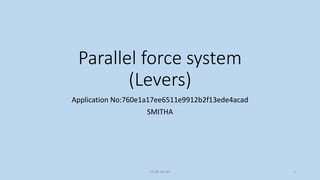
Levers assignment
- 1. Parallel force system (Levers) Application No:760e1a17ee6511e9912b2f13ede4acad SMITHA CC BY-SA-NC 1
- 2. PARALLEL FORCE SYSTEMS - It exists whenever two or more parallel forces act on the same lever but at some distance from each other and at some distance from the axis about which the lever will rotate. - Each of the forces in a parallel force system will create or tend to create rotation of the lever about its axis. - A lever is a rigid bar which is capable of movement about a fixed point called as fulcrum(F). CC BY-SA-NC 2
- 3. - In a human body, a lever is represented by a bone which is capable of movement about a fulcrum formed at the articulating surface of a joint . - Effort is supplied by the force of muscle contraction applied at the point of intersection to the bone. - The weight may be either at the centre of gravity of the part moved or object lifted. - Effort force(EF) is defined as the force that is causing the rotation of the lever. CC BY-SA-NC 3
- 4. CC BY-SA-NC 4 - Resistance force (RF) is the force that is opposing the rotation of the lever. - Lever arm in a parallel force system is the distance from the axis to the point at which a force is applied to the lever. - The effort arm (EA) is the lever arm of the effort force or how far the effort force lies from the axis. - Resistance arm(RA/WA) is the lever arm of resistance force or how far the resistance force lies from the axis.
- 5. First class levers/lever of stability/first order levers - It exists whenever two parallel forces or parallel resultant forces are applied on either side of an axis at some distance from that axis, creating rotation of the lever in opposite directions. CC BY-SA-NC 5 EA RA EF RF F/A
- 6. CC BY-SA-NC 6 EA RA EA RA EF R EFR REF EA RA
- 7. - In a first class lever, EA may be greater than, smaller than or equal to RA because the axis may be located anywhere between effort force and resistance force without changing the classification of the lever. - Examples 1. Seesaw CC BY-SA-NC 7 A B
- 8. - Man B is effort and effort force is causing the rotation of the lever. - Man A is the load and resistance force is force that is opposing the rotation of lever. - See saw is going down on the side of Man B. - If the seesaw were balanced (equilibrium) ,neither force would cause motion . - When equilibrium does not exist, rotation of the lever will occur. CC BY-SA-NC 8
- 9. 2. Nodding movements of head, skull is the lever, atlanto occipital joint is the fulcrum, weight is anteriorly in the face. The effort is applied by contraction of posterior neck muscle. CC BY-SA-NC 9
- 10. 3. Scissors 4. Crowbar CC BY-SA-NC 10
- 11. Second class levers/lever of power/second order lever - It exists whenever two parallel forces are applied at some distance from the axis, with the resistance force applied closer to the axis than the effort force. CC BY-SA-NC 11 EA RA R EF F/A
- 12. - EA is always greater than RA. - In the human body it occurs when gravity is the effort force and muscles are the resistance. - Examples 1. Wheelbarrow CC BY-SA-NC 12
- 13. 2. Nutcracker CC BY-SA-NC 13
- 14. 3. - Action of triceps surae lifting the body (effort) around the axis of the toes(MTP) . - Body weight acting on foot through LOG is resistance. CC BY-SA-NC 14
- 15. Third class levers/lever of velocity/third order lever - It exists whenever two parallel forces on a lever are applied so that the effort lies closer to the axis of the lever than the resistance. - EA will always be smaller than RA - Most of the muscles creating rotation of the distal segments are part of third class lever. - Point of attachment of the muscle causing motion is always closer to the joint axis than the external force that is resisting the motion. CC BY-SA-NC 15
- 16. - Greater effort is needed than the amount of resistance moved. CC BY-SA-NC 16 EF R EA RA
- 17. - Examples. 1. Forceps CC BY-SA-NC 17 2. baseball bat
- 18. CC BY-SA-NC 18 3. In the human body
- 19. Acknowledgement Sources of images: Internet MOOC- SWAYAM – Academic writing 2019 (August –November) CC BY-SA-NC 19